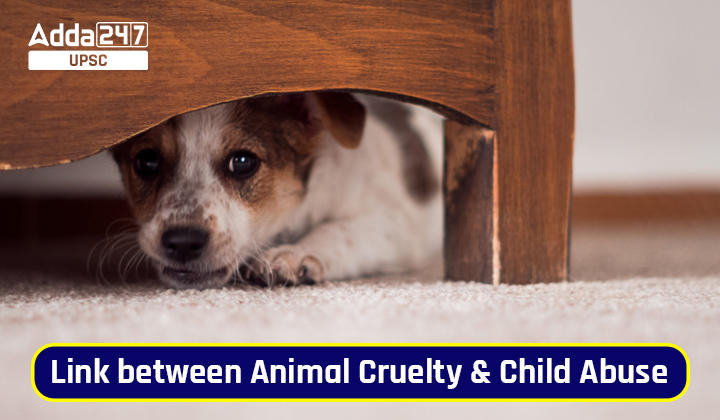Table of Contents
Child abuse remains a pervasive issue in India, with alarming statistics highlighting the prevalence of physical, sexual, and emotional abuse. Despite efforts to address the contributing factors such as family structure, poverty, and cultural influences, a crucial aspect has often been overlooked—the connection between child abuse and animal cruelty. This article delves into the intricate relationship between these two forms of violence, emphasizing the need for collaboration between child protection and animal welfare movements. By reporting and prosecuting animal cruelty, we not only save innocent lives but also create a safer environment for our children.
Historical Link: From William Hogarth to Modern Studies
- The revelation of a link between animal cruelty and human violence dates back to William Hogarth’s “Four Stages of Cruelty” in 1751.
- Subsequent studies, particularly a 1980 pilot study in England and a 1983 study in New Jersey demonstrated a compelling connection between households that abuse family pets and those at risk of child abuse.
- These findings underscore the need to recognize animal cruelty as a potential precursor to more severe forms of violence within a household.
Coercion and Control: Threats and Violence Towards Animals
- A 2019 study in the U.S. revealed a disturbing tactic used in homes with interpersonal violence—threats and violence towards animals to coerce children into compliance.
- In 12.3% of cases, animals are targeted to ensure the silence of children, who fear repercussions for themselves or the animals.
- Understanding coercive dynamics sheds light on the intricate ways in which abusers manipulate their victims and the significance of addressing both animal and child welfare to break the cycle of abuse.
Detection Challenges
- In many cases, animal abuse is easier to detect than child abuse, providing an early indicator of potential harm within a household.
- Victims of domestic violence, including children, may find it easier to report instances of animal cruelty, serving as a crucial starting point for intervention.
- Recognizing the signs of animal abuse can be instrumental in identifying homes at risk and preventing further harm to both animals and humans.
Urgent Need for Investigation in the Indian Context
- Despite the compelling evidence from international studies, there is a notable lack of empirical assessment regarding the link between animal cruelty and child abuse in the Indian context.
- The absence of data collection under the Prevention of Cruelty to Animals Act, of 1960, further hinders our understanding of the co-occurrence of these crimes.
- Urgent investigation and data collection are imperative to inform policy, allocate resources effectively, and protect the vulnerable members of our society.
Strengthening Enforcement: The Role of Anti-Cruelty Laws
- Enforcing anti-cruelty laws not only safeguards animals but also plays a pivotal role in preventing violence against humans.
- The National Crime Records Bureau’s current oversight in collecting data on offenses related to the Prevention of Cruelty to Animals Act is a critical gap that needs urgent attention.
- Learning from the experiences of other countries, and aggregating data on animal cruelty offenses can enhance our understanding of the overlap with other forms of violence, providing valuable insights for law enforcement agencies.
Collaborative Solutions: Bridging Child Protection and Animal Welfare Movements
Recognizing the shared victimization by the same perpetrator, there is a unique opportunity for stakeholders in the child protection and animal welfare movements to collaborate.
By aligning their objectives and resources, these movements can work towards a common goal of reducing abuse in all its forms. explores potential collaborative initiatives and emphasizes the collective impact of addressing both child and animal welfare.
Reporting for a Safer Future: Deterrence and Protection
- Reporting and prosecuting cases of animal cruelty extend beyond saving animals; they are integral to protecting our children from violence and securing a brighter future for them.
- Understanding the link between animal cruelty and child abuse allows us to disrupt the cycle of violence at its source.
- By consistently reporting, registering, and prosecuting cases involving animal cruelty, we create a deterrent against further acts of violence, fostering a safer environment for both animals and humans.
Conclusion
In conclusion, the link between animal cruelty and child abuse is a critical aspect of the broader issue of violence within households. Recognizing and understanding this connection is essential for effective intervention and prevention strategies.
By enforcing anti-cruelty laws, collecting relevant data, and fostering collaboration between child protection and animal welfare movements, we can break the cycle of abuse and create a safer, more compassionate society for our children and animals. It is a collective responsibility to report, prosecute, and actively work towards a future where both children and animals are free from the shackles of violence.



 TSPSC Group 1 Question Paper 2024, Downl...
TSPSC Group 1 Question Paper 2024, Downl...
 TSPSC Group 1 Answer key 2024 Out, Downl...
TSPSC Group 1 Answer key 2024 Out, Downl...
 UPSC Prelims 2024 Question Paper, Downlo...
UPSC Prelims 2024 Question Paper, Downlo...
